Local plants and ayurvedic compounds
Towards a robust and ethical practice
Photo by Ben Guernsey on Unsplash
A Practitioner’s Discomfort
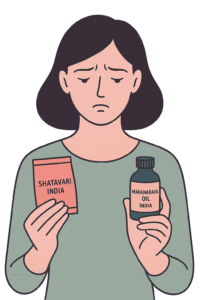
When I began studying and practicing Ayurveda in Europe, I carried a quiet sense of discomfort — one that has only grown with time. The more I work with this tradition, the more I become aware of how far my practice can drift from the ecological intelligence that lies at its heart.
Most of the herbs and formulas I use travel thousands of kilometres. Cultivated and processed in South Asia, they are packaged, shipped, and sold across continents, arriving here months after harvest — long separated from the vitality (prāṇa) that makes a plant truly alive.
This dependence raises both ethical and practical questions. Ethically, it ties us to the same globalised health system whose ecological cost is now well documented — for example, by The Shift Project, which highlights the enormous carbon footprint and resource use of the healthcare sector.
Practically, it makes little sense: how can we speak of Desha (place) and Kala (season), fundamental Ayurvedic principles, while relying so heavily on imported materia medica? These plants did not co-evolve with us here.
This is not to suggest, of course, that South Asian plants are dispensable or that we can or should do without them altogether. Many possess unique properties and a long history of empirical use that make them irreplaceable for certain classical formulations.
Yet, alongside their continued importance, there is value in systematically exploring how locally available plants might be integrated in our practice here — reducing dependency where possible and deepening Ayurveda’s dialogue with the ecosystems in which it is practiced.
Ayurveda is a global system, born from the observation of living systems.
If it is to remain a living science of life, it must be adapted to the ecosystems where it is practiced.
Why work with local plants
Ayurveda as a living science of relationship
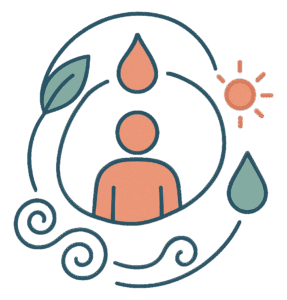
At its essence, Ayurveda is a science of relationships (see What is Ayurveda therapy) — between human beings, food, plants, seasons, and the wider web of life. The classical texts teach us to consider Desha (the place), Kala (the time), and Patra (the individual) before offering any remedy.
When plants grow in the same landscape as us, they share the same climate, air, and microbial life that shape our physiology. They carry the same subtle adjustments to temperature, moisture, and light that we do. Working with local plants is not simply a matter of convenience — it is a matter of resonance.
In contrast, the modern health system — including much of “natural medicine” — often follows a linear and extractive logic: isolate an active compound, reproduce it anywhere, transport it everywhere. The result is neither ecological nor truly effective in pursuing the objective of physical and mental balance, as understood by traditional approaches.
Ayurveda as permaculture
Long before I began studying Ayurveda, I was drawn to permaculture. What first captivated me was its way of seeing the world — not as a collection of separate parts, but as an interconnected web of relationships. Permaculture teaches us to look at how each element supports the whole: how soil, water, plants, animals, and people interact, and how every interaction creates ripple effects throughout the system.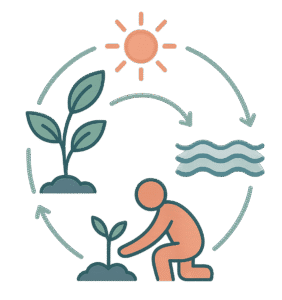
When I later discovered Ayurveda, I felt a deep sense of recognition. Here, too, was a systems approach — a way of understanding health as the harmony of relationships within the individual and between the individual and their environment. Ayurveda, like permaculture, also rests on an ethics of care: care for people, and a commitment to work with nature rather than against it.
Beyond care for people, permaculture also offers an ethics of care for the Earth and of Fair Share — a call to restore balance within living systems. This perspective gives me a broader framework within which to practice Ayurveda. It invites me to think not only about the health of the person in front of me, but also about the health of the ecosystems and social environments that sustain them: the soil that nourishes their food and medicine, the communities that shape their resilience. It also reminds me to see plants not as resources, but as participants in a vast conversation of energy and exchange.
If I take this vision seriously, it naturally leads to a simple shift: to rely as much as possible on herbs that are locally grown, seasonal, and organically cultivated. Sourcing plants in this way honours both the ecological and ethical dimensions outlined above. It reduces the environmental footprint of transport and processing, and supports local growers and biodiversity.
Regenerative, Robust, Systemic, Ethical practice
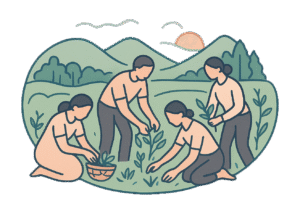
If I take this vision seriously, it naturally also pushes my practice in a specific direction — to give back to the systems that give to me. In this sense, Ayurveda as permaculture is not a metaphor but a method — a way of designing health systems that regenerate rather than deplete, that integrate rather than isolate.
Working with local plants and reducing dependency on global supply chains are small but meaningful gestures toward this. A part of the attempt to shape my practice in ways that feel systemic, robust, regenerative and ethical:
- Systemic means that health isn’t just something that exists in one body. We are connected to our environment, our communities, and the ecosystems that sustain us. My practice tries to take all of this into account.
- Robust means resistant and adaptive. Ayurveda has survived for millennia because it can respond to new climates, new bodies, new challenges. A robust Ayurvedic practice in Europe must adapt to the ecological realities of this bioregion and the growing need for local self-sufficiency, as well as reconnect with local traditions and knowledge keepers.
- Regenerative means that my practice should nourish rather than deplete. It should support the health of the environment, and the well-being of the communities it is part of. Reducing imports, protecting biodiversity and nurturing local ecosystems is part of this.
- Ethical means practicing with respect — for the plants I use, the cultures I learn from, and the people I serve. It also means making Ayurvedic practice more accessible and sustainable for local communities.
Together, these four qualities form the roots of what I call a Regenerative Ayurveda — an Ayurveda for our time and place.
Adapting Ayurvedic Formulations Locally
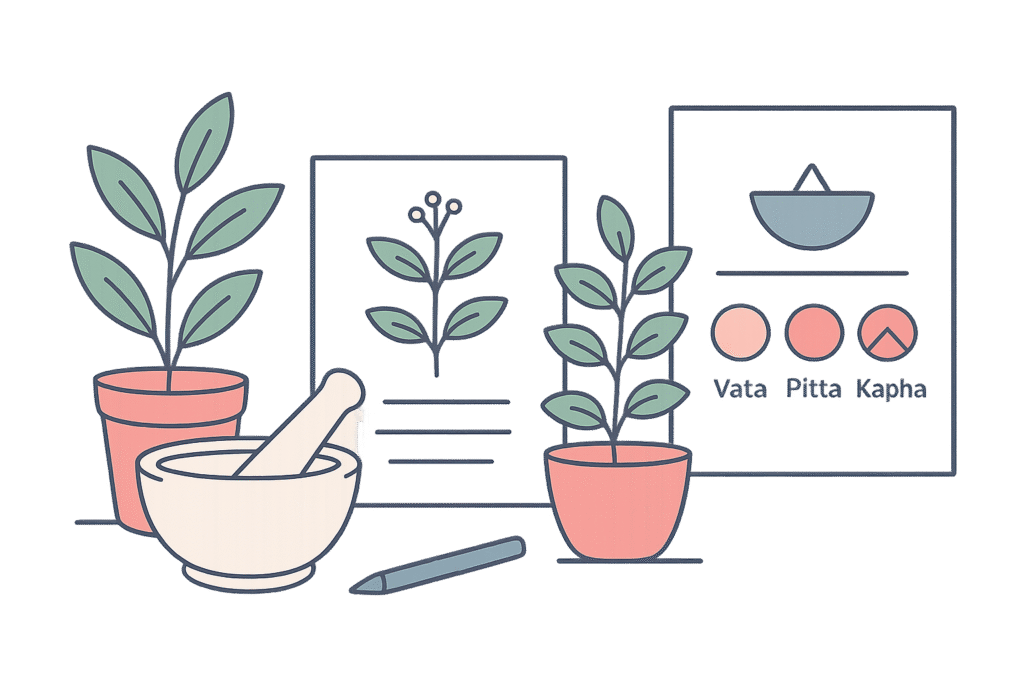
Ayurvedic readings of single herbs
Historically, healers in Europe did read plants for their qualities — using taste, texture and the humoral framework (hot/cold, dry/wet) to judge effects on the body. This practice is evident in Galenic medicine, medieval herbals, and what became known as the doctrine of signatures. However, over the past two centuries this heritage has been marginalised. The dominant medical paradigm shifted toward phytochemistry, pharmacology and formalised pharmacopoeias, which emphasised “active compounds,” dosing and standardisation. As a result, today we more commonly find phytochemical and pharmacological descriptions (anti-inflammatory, sedative, antimicrobial) rather than systematic accounts of taste (rasa), qualities (guna), or potency (virya).
To use local plants effectively, we first need a reading of their “energetics.” Ayurveda provides a rich language and methodology for exploring local flora in this sense. Observing taste (rasa), qualities (guna), potency (virya), post-digestive effect (vipaka), and action (karma) allows us to build nuanced knowledge over time.
A range of resources can support this process. Manuals specifically addressing an Ayurvedic reading of European herbs are scarce — for example, Dravyaguna for Westerners by Athreya Smith — but other materials can provide complementary insights. Traditional Chines Medicine (TCM) and Traditional Greek Medicine readings of herbs (e.g., Peter Holmes’ Energetics of Western Herbs, and online resources such as Herbal Reality and Medicine Traditions) offer information on taste, potency, and systemic effects, although they may require some knowledge of TCM, TGM or Galenic principles. Manuals on phytotherapy, focusing on the biochemical composition and actions of herbs, may also enrich this reflection.
Ayurvedic formulations of local plants
Creating local formulations presents several challenges. First is the lack of systematic Ayurvedic reading of local plants in Europe, as noted above. Secondly, the national pharmacopoeia (in France) reserves most medicinal plants for doctors and pharmacists. Practitioners of Ayurveda and other herbal traditions must navigate a narrow space between respecting the law and using local plants (see list of freely available medicinal plants in France). Finally, classical Ayurvedic training emphasises formulas with specific indications, contraindications, and therapeutic goals, the design of which requires advanced training and Dravyagunakarma-shastra.
While some local products such as “Vata oil” or “Vata spice blend” exist, they often have limitations:
- The skill of a practitioner lies in selecting the best solution for the individual, not providing generic one-size fits all remedies. Two people with a “Vata imbalance” may require very different blends based on their constitution, environment, and other imbalances – this is precisely where Ayurveda shines: personalisation. As Ayurveda is much more than balancing a generic Vata, Pitta, or Kapha, formulas also need to address specific dhatus, srotamsi, and nuanced qualities, with clear indications and contra-indications.
- Existing local formulas on the market may well be “the best solution” in certain situations. However, the practitioner may not be able to determine whether this is the case if they lack advanced herbal knowledge, and/or lack access to the exact recipe. Proprietary mixes often lack this level of transparency, limiting feedback, adaptation, and collective learning.
What is needed is local complements with publicly accessible recipes, and conceived with clear therapeutic goals – in the ayurvedic sense. Formulations are not fixed recipes, but intelligent designs. Each ingredient included in classical Ayurvedic complements contributes to a synergistic effect. By studying these complements’ structure — main herb, supporting herbs, harmonising agents — we can thoughtfully reimagine local equivalents with comparable energetics.
Building bridges between traditions and sharing openly
This approach requires humility and respect. Ayurveda has deep roots in South Asia, while Europe has its own herbal traditions and knowledge. The goal is not to appropriate or replace, but to build bridges: creating a dialogue between systems, learning from each other, and sharing knowledge openly.
Creating transparent local formulations honours both the wisdom of classical Ayurveda and local ecological and cultural knowledge. It fosters living commons of practice, allowing practitioners and herbalists to refine, adapt, and learn from experience.
How this section will grow and how to use it

This page marks the beginning of an ongoing exploration. Over time, this section of the website will grow into a living library of reflections and research notes, including:
- Ayurvedic profiles of local plants found in Ariège and across temperate Europe — notes meant primarily for my own reflection, but which may also be useful to others.
- Analyses of well-known classical Ayurvedic formulas and experimental recipes that could provide local equivalents — intended for practitioners wishing to experiment with local formulations, and for producers interested in creating Ayurvedic complements based on local products.
This is an open field of research — a garden of ideas where observation, experimentation, and dialogue are essential. Practitioners, herbalists, and curious readers are invited to walk this path alongside me: to taste, to observe, and to share their insights. Ayurveda, after all, is a living science; it grows richer when it is shared.
A living library in progress
This project is growing slowly — with new plant profiles, reflections on regenerative Ayurveda, and experiments in local formulations.
If you’d like to follow along, subscribe below to receive occasional updates and notes from the field. Alternatively, you can also follow along on Instagram or Facebook.
Join the Exploration — Share Your Reflections or Questions
Ayurveda thrives through dialogue, observation, and shared experience. If you’re exploring similar questions, experimenting with local plants, or simply curious about this approach, I’d love to hear from you.



